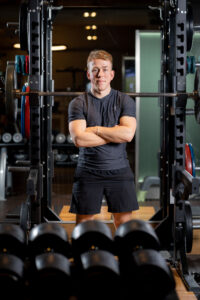When people aim to lose body fat, there are two very common mistakes that are made. The first of which, when it comes to nutrition, is to drastically reduce how much you eat and restrict yourself from any foods that you enjoy eating. It can be very easy to get into the mindset that eating as little as possible is going to get you to your goal(s).
The second mistake that a lot of people make is drastically increasing their cardio. Again, it is a common thought that by increasing your energy output by doing lots of cardio is going to burn that fat and make you leaner. Although cardio does indeed burn plenty of calories, the more efficient you become at cardio, the fewer calories you are going to burn from it. Furthermore, and perhaps more importantly, too much cardio will lead to a ‘skinny fat’ physique, where you do not have a proper structure and shape to your body and you instead have a much smaller frame, with some fat still hanging on.
Both of these approaches are exactly what you should not be doing when it comes to losing more body fat because it reduces your body’s efficacy to burn more calories. So, what is the right way to approach further fat loss? How do you increase your body’s ability to burn more fat? Here are the strategies that you should be adopting to achieve exactly that.
Gradually Increase Your Calorie Intake
The first thing you need to sort out is your nutrition. Eating too few calories is ineffective and dangerous because it will drastically slow down your metabolism (the range of biochemical processes that occur within your body to break down food into energy) and soon put a halt to the fat-burning process. Therefore, all your hard work in the gym and supposed ‘discipline’ with your nutrition will be for nothing.
So, while it is essential to be in a calorie deficit, that deficit has to be moderate and not extreme, which is usually 400-600 calories below your maintenance level (the calories you need to consume to stay the same weight and look the same, based on your height, weight, amount of muscle tissue and activity levels). By doing this, you will enable your metabolism to function properly and lose body fat more consistently, as well as keep your energy levels to a relatively high level.
Start Doing Resistance Training and Lift Heavier

If you continually do cardio as your main source of exercise, things will stagnate. While you may see some initial weight loss and fat loss, it is not a sustainable, long-term solution because your body’s ability to burn more fat will decrease, leading to that ‘skinny fat’ physique. The only thing that will improve will be your endurance and cardiovascular health.
By consistently doing resistance training as your primary source of exercise, you are going to build muscle (tone up), which will not only add a better structure and overall look to your body but also increase your fat-burning process because the body requires lots of energy (calories) to maintain lean muscle tissue. Therefore, your Basal Metabolic Rate (the number of calories your body burns without you doing anything) will increase. The resistance training sessions themselves also burn lots of calories, so they are an essential part of the fat-burning process.
Improve Your Macronutrient Split And The Quality Of Your Nutrition
While being in a calorie deficit over a long period of time is the most important thing when it comes to fat loss, you also need to prioritise the quality of your nutrition. This involves improving your macronutrient split (hitting your protein target, adding in carbohydrates and fats) and consuming healthy, unprocessed foods. Higher intake of protein is going to increase protein synthesis (the process in which cells make proteins) in your body, which is vital for muscle health, recovery and growth. Carbohydrates are going to be your primary energy source, so that you can progress in your training sessions when it comes to weight lifted, intensity and overall performance.
Staying away from highly processed foods is going to be important because this will reduce potential inflammation in your body, which lowers internal oxidative stress and improves overall digestion. It is also important for general health that you get a good balance of protein, carbohydrates and vegetables in your meals, with healthy fats included too – these meals will be the building blocks to you having a productive day that will take you one step closer to your goal.
Re-Feed Days

This is a very effective technique you can use when you are deep into a fat loss phase. Once you have lowered your levels of body fat significantly and you want to lose more, incorporating a refeed day is going to be important. This is because, when you have been in a calorie deficit for a long period of time, your metabolism gradually slows down as a result of reduced food. Therefore, your body’s fat-burning efficiency will decrease and, combined with the difficulty of losing more body fat as you get leaner, it can be very easy to stagnate.
By introducing a re-feed day, where you increase your calories back up to maintenance (the number calories you need to consume to stay the same weight) you are giving your metabolism a kickstart and a boost so that the fat-burning process can continue at an efficient rate. Make sure those extra calories come in the form of carbohydrates and to a lesser extent, fats – you do not need to increase your protein intake if it is at the right level. This will also improve your energy levels so your workouts can be highly productive and effective.
Walk More
While you should incorporate some form of cardio into your daily routine, hours and hours of high intensity cardio every day is unsustainable, unenjoyable and unhealthy for lots of people. So, it is important to find a form of cardio that you can consistently perform every day without overworking your body. Low-Intensity Steady-State cardio is an excellent option because it is more sustainable and enjoyable for people.
An hour of walking can burn up to 300 calories, depending on the individual. So, combining this with your resistance training sessions means that you could be burning up to 1,000 calories from them both, on training days. Then, throw in all the Non-Exercise Activity Thermogenesis (NEAT) calorie output (calories burned outside of exercise e.g. cooking, gardening, making your bed), along with your Basal Metabolic Rate (BMR) (the number of calories you burn if you without doing anything), and you will have created a calorie deficit for yourself.
It can be very easy to stagnate when you are looking to burn even more body fat and get leaner. However, these points are vital for making sure that you keep progressing and that all your work will not be for nothing. Once you do this, you are well on the way to achieving your dream physique.
Photo Credit: Envato Elements


